Copyright 2011 by Gary A. David, islandhills@cybertrails.com
We can imagine the members of the first village at Homolovi (settled circa A.D. 1260 near the present town of Winslow, Arizona) gathering before dawn on the summer solstice in an alcove-like enclosure of rock not far from their pueblo. Here they await the sacred interplay of shadow and sunlight. The main panel, which faces eastward, is created by a vertical sandstone fault about 25 feet long and 15 feet high. It is capped by an overhanging slab that extends horizontally about four feet to the east.
Approximately 10 feet to the east is a round-topped boulder that forms the inner east wall of the enclosure and casts a curved shadow upon the main panel. Open to the south but blocked to the north by broken chunks of rock heaped higher than their heads, this enclosure protects the observers who sit cross-legged and close together on the ground, gazing in rapt attention at the primary grouping of petroglyphs on the main panel.
These petroglyphs include a long, abraded line (possibly symbolizing migration) curving upward and to the right, finally ending in a spiral comprised of four revolutions. Near the bottom of the panel immediately to the right side of this "trail" is a somewhat circular "corral" that contains a zoomorph in profile. Its head faces obliquely upward and to the right.
In between the trail and the left side of the corral is one vertical zigzag snake, while on the right side is a pair of similar zigzag snakes, all of which have recently been defaced.
Slightly above and a few inches to the right of the spiral is a glyph depicting some sort of V-shaped "artifact" pointed downward. To the right of this we find a large equilateral cross formed by an oblique axis we shall call the "plumed serpent," carved from the top left to the lower right of the panel. A "vertical axis" bisects this oblique line and extends downward to nearly the same height as the bottom of the corral, ending in a cupule about one inch in diameter.
To the far right (or north) at the same height as the center of the cross, there is a petroglyph of an antelope-- a pronghorn with its head facing to the left. Viewed as a composite, these petroglyphs are about eight feet long.
The sun priest's low, plaintive chant mingles with pungent smoke of juniper leaves smoldering on a chill desert wind. At about 5:15 a.m. the upper arc of the sun's disk flows like molten gold over the edge of the world. Within a few moments orange sunlight bathes the top of the panel, while the eastern wall of the enclosure begins to cast a gently arcing, horizontal shadow.
Soon this shadow-being starts to crawl down the panel, passing consecutively through a number of petroglyphs: the head of the plumed serpent, the center of the spiral, the V-shaped artifact, the intersection of the cross, the antelope, the corral, and a group of heretofore unmentioned clan petroglyphs on the far left. One section on this generally horizontal shadow has two right angle jogs that first nestle the plumed serpent's head as they pass through and then follow the slight curve on the upper portion of the vertical axis. (See Photo 2. The three holes at the top of the photograph are recent bullet holes.)
This progression has already taken over an hour when the shadow finally touches both the cupule at the bottom of the cross's vertical axis and the beginning of the trail at the lower left. The horizontal shadow continues downward for another half hour, after which it finally leaves the panel altogether. Chants to both the sun god Tawa and the chthonic spirits accompany this "sacred appearance," as an aura of the miraculous pervades the gradually warming air of morning.
Just as this shadow creature is departing, another one formed by the overhanging slab begins to proceed down the vertical rock panel. Because of the irregularities on the edge of this horizontal slab, its adumbration has a number of bumps and notches that interact with specific petroglyphs during various stages of the spectacle.
In comparison with the former shadow discussed, this one will create a dynamic synergy of sunlight and shade that staggers the mind. Not unlike a written account of the movements in a ballet or --more germane to our discussion -- the ritual acts of a kachina dance, any description of this presentation is bound to fall short of its actual intricacy and sanctity. In other words, the play's the thing. (See Photo 3.)
For about an hour and 45 minutes the "large bulge" on the right side of the shadow has been inching down the rock panel. Now at 8:45 a.m. the "small bulge" is poised directly above the antelope, the "nipple" rests above the vertical axis, and the "large notch" hovers above the head of the plumed serpent.
Nearly an hour later the horizontal section of the shadow to the right of the large notch bisects the antelope, while the horizontal section to the left bisects the V-shaped artifact. At this point the notch itself is lodged on top of the vertical axis.
After five minutes this same horizontal section to the right reaches the feet of the antelope, while the horizontal section to the left touches the lower tip of the artifact. Simultaneously, the lower left side of the notch is almost at the center of the cross. In addition, a smaller notch which has formed to the left of the larger one is lodged between the artifact and the spiral. Furthermore, the curving shadow to the left of this smaller notch grazes the upper part of the spiral.
In seven minutes the left side of the shadow reaches the center of the spiral, and the large notch begins traveling down the lower part of the oblique plumed serpent.
Approximately 20 minutes later the large notch reaches the end the serpent, while the left side of the shadow touches the outer left curve of the spiral, where it will remain for nearly two more hours. (See Photo 4.)
As the small notch begins traveling down the bottom part of the vertical axis, the left side of the large notch touches a small cupule located at the tail of the serpent. It is now 10:40 a.m.
After about another half hour, the horizontal lower edge of the whole shadow has moved off the panel, though its left side still rests on the left side of the spiral. Around noon the shadow which has obscured the spiral since about 10:00 a.m. begins to move again, back though its rings toward the right.
Thus far, we have been dealing primarily with shadow against stone. Now another element enters into the play. Near the top left side of the whole shadow, a triangle of light forms. A few minutes after noon this triangle begins to move downward toward the spiral. At about 12:30 p.m. this triangle splits into two smaller triangles of light. When these lights pass directly into the center of the spiral, however, they merge. (See Photo 5.)
This one triangle proceeds downward and passes out of the spiral, where it again splits into two smaller triangles of light. The left side of the whole shadow is now passing through the corral, the only time it is obscured.
During this seven and a half hour show the shadows of the netherworld have joined the great sun god resurrected in his summer house which rests at the most northern point on the eastern horizon. Yet only when he is at his highest is his luminous power made manifest at the spiral, the gateway between worlds. With one final resonant chant, the sun priest ardently ushers in this portion of the seasonal procession, and the orderly cosmos is maintained for all.
If this is indeed a star map, then to what constellations do the individual petroglyphs correspond? First of all, the large four-armed cross is a sort of Hisatsinom "swastika" formed by the intersection of the oblique plumed serpent and the vertical axis. (The swastika is far older than the Nazi regime. For the Pueblo peoples it has a sacred rather than a malevolent connotation.) This cross specifically represents the rectangular (i.e., four-sided) shape of Orion.
Equidistant between the plumed serpent and the spiral is the V-shaped artifact, directed downward to radiate its stellar power to the Earth. If we look at a sky chart in the region of Orion, we notice that the V-shaped Hyades of the constellation Taurus lies adjacent to Orion in the same relative positioning we find on the panel. In addition, to the left of the V-shaped glyph is located the spiral, which on the sky chart corresponds perfectly to the Pleiades. Here we have three glyphs in a row corresponding directly to the configuration of three major constellations. But the correlative factors do not stop here. (See Diagram 1 for the petroglyph grouping with constellations marked.)
To the right of the equilateral cross of Orion is the glyph of the antelope. Looking to the sky chart in the same relative position, we find the brightest star in the heavens, Sirius in Canis Major. Still other constellations are portrayed.
Just below a gentle curve in the vertical line are two abraded marks, one on each side. This line continues downward until it terminates in an abraded mark made inside a natural cupule. A few inches to the right is another slightly larger natural cupule. Looking at the sky chart, we find these correspond collectively to the more narrowly rectangular constellation Gemini. The upper pair of marks represents Alhena and Mu Gemini, while the lower pair Pollux and Castor.
Perhaps it is merely a coincidence, but a natural groove in the panel cuts horizontally just above Alhena. Celestially this corresponds to the Milky Way. In addition, the tip of the plumed serpent's tail correlates to the constellation Canis Minor with its prominent star Procyon.
Again consulting the sky chart, we find one more constellation represented on the Homolovi star map. The aforementioned corral at first glance appears rather circular, but upon closer examination we find that it is five-sided. The Hisatsinom had no technical difficulty incising a perfect circle in stone, if that is what they intended. The deliberately pentagonal figure, then, corresponds to Auriga.
More recently the zoomorph inside the corral has been badly defaced, so it is difficult to determine its species. Nevertheless, it could quite possibly represent a mountain goat or a mountain sheep. The brightest star of this constellation is Capella, which means "little she-goat."

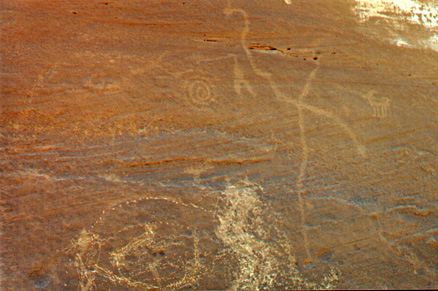
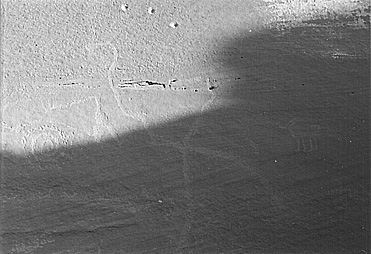
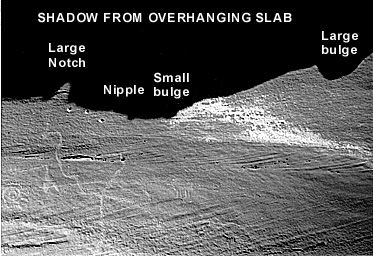
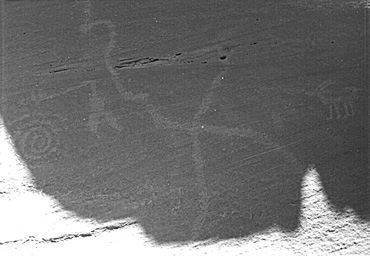
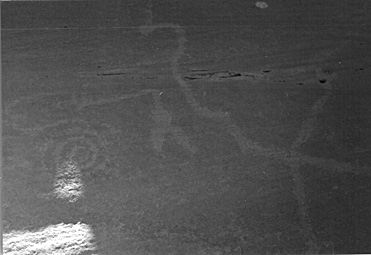
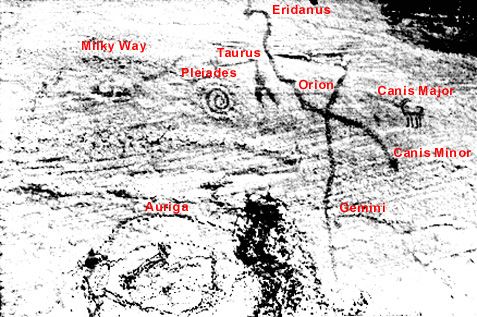

Other history related articles on this site:
.
.
.
.
.
.
.
.
.
.
.
.
If you have a suggestion or history related article to submit, send it to:
Editor/viewzone.com
myristicin@hotmail.com